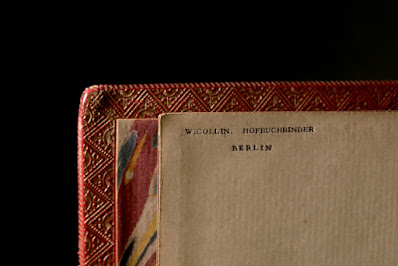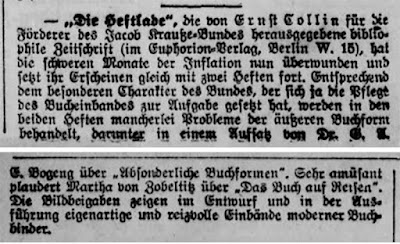By Peter D. Verheyen
This article is adapted from the original, published in the Guild of Book Workers'
.
On June 1st of this year, Book_Arts-L was migrated from Syracuse University’s servers to Emory University. This date was a month shy of the list's 29th anniversary, an eternity in the online world. But, what is Book_Arts-L, and why did I create it?
The “Internet” as we know it now with the
World Wide Web (WWW) was invented by Tim Berners-Lee on April 30, 1993, though its conceptual origins go back even further.. In 1987,
Walter Henry at Stanford created the Conservation Distlist, the first discussion group for all things conservation, accessible via email from anywhere in the world, if you had a connection. I got connected to it in early 1989 with a slow dial-up modem and a
Compuserve account. Despite its focus, other topics more binding and art related crept in, something I was certainly guilty of contributing to and encouraging. Walter Henry was very patient, but also encouraging of my questions. In 1990,
Peter Graham, a librarian at Rutgers, founded Exlibris, an online discussion group for rare books and special collections with many opportunities for exploring topics related to the book arts.
The world was still overwhelmingly analog at the time, newsletters like the
Guild of Book Workers’, the
American Institute of Conservations', and the
Abbey Newsletter, among others, with their calls for exhibits, workshops, and jobs, were eagerly-awaited resources. I was fortunate to spend those early years in places with active book arts and conservation scenes, such as Chicago and New Haven, so in-person activities also played a large role.
In 1993, I moved to centrally isolated Ithaca, NY, where I was rare books conservator at Cornell. Compared to my past haunts, Central New York was a very barren and remote place to practice the book arts.. Attempts were made to form a loose regional group with a newsletter, but this never succeeded in building the active critical mass required for success. Was there any help for getting out of this professional and avocational loneliness? Could these new online tools, like listserv and gopher (a precursor to the web), help? Typo-L, a list which continues to serve the typographic community, was founded in early '93. For much of its first year, however, that list was unusually quiet, with numerous "is anyone else out there" messages. I also happened to be unaware of its existence.
Encouraged by Walter and Peter, I founded Book_Arts-L in June 1994 on Cornell's list server, and it was announced on the
DistList and
Exlibris. It was my turn to see “who was out there”. I knew about some of the technical details, but was clueless about what I was getting myself into. The subscriber list grew slowly, but steadily, as did participation, and by the end of that first year there were about 400 subscribers with as many postings. When I moved to Syracuse, the list followed me there as well. In 1997, there were 900 members with 3000 postings. Initially, I found myself doing quite a bit of "handholding" as people learned how to subscribe,use a listserv and use email. To some extent this continues to happen, though much more infrequently. With time, most of these challenges faded away, and the list grew to a peak of over 2500 global subscribers. Managing those could have been a chore, but was generally a great deal of fun as one gets to know like-minded people all over the world. Some of my virtual connections are still ongoing and sustaining, and have led to collaborations and other opportunities for both parties.
Walter Henry offered to host its archives at CoOL, initially on a
Gopher server and shortly thereafter to the WWW. The archive remains available to subscribers via the web in different places including the Internet Archives's Wayback Machine (
1994-2009). It is my wish to pull all these together in a unified and consistent interface, but that will require some work and goes beyond my abilities.
Not content to simply discuss technical matters, within weeks we were debating the essence of the book. This topic would recur periodically, and it exploded in the spring of 1998 around the question of defining the artists’ book. An "innocently simple" question, looking for a definition of "artists’ book", results in 89 printed pages that are still regularly read and cited. Like many other discussions, it traveled a very circuitous routes, becoming "what is art," the difference between "art” and “craft," the definition of "craft," training, technical competence... While there the ubiquitous "me too" replies, the list and its archive nevertheless became a great repository of collective experience and knowledge about such arcane topics as reconditioning a press, finding a particular supplier, using materials, and how to practice the craft of bookbinding. The quality of postings varies, determined by the expertise of the poster, but even a simple or naive post serves an educational function as well. We all learn best from our own or others' experiences. Sustaining all this learning is an incredible global community of individuals who share generously of themselves. In a few cases, participation has become multi-generational, with parents and offspring contributing to the discussions. Those early days, including beyond Book_Arts-L were the topic of
Bringing us together / Getting us out presented at Hot Type in a Cold World, the Silver Buckle Press' 25th anniversary symposium.
In the early days, the idea of Book_Arts-L, an online community, or pretty much any presence of our allied arts and crafts on the then-newish internet was not met with universal acceptance. Indeed, there were numerous voices that spoke out against it within the Guild and its membership, as well as other similarly-focused organizations. Among the concerns were gatekeeping, “trust”, fad, and fears for the survival of print publications such as newsletters. When I started Book_Arts-L, I had no idea how long it would last. Almost 30 years later, numerous other friendly and aligned lists and fora appeared, and then faded. The book arts, and related fields, have also proliferated on social media. While they do provide easy ways to share work, especially images, such platforms are not well suited to long form discussions.
So, what has contributed to Book_Arts-L’s success? I believe that the most significant factor is [pro]active stewardship – as list owner starting and contributing to threads, and sharing resources, especially during lulls. While lulls in conversation are natural, and often good, in the context of a resource like listservs and for a it can lead to “out of sight, out of mind”. Also, important are actively engaging with subscribers, especially when topics become contentious, along with occasional calls for civility. A global community is a microcosm of society with all that implies, and contexts in one place may not be the same elsewhere. The list language is English, but that is not everyone’s native language – things can be lost in translation. It was my role to make sure that things did not get too heated. These challenges were however a very small part in the history of Book_Arts-L largely because of the [pro]active stewardship.
In 2019, on the 25th anniversary of Book_Arts-L, I made the decision to step back by the 30th, quietly hoping that the list would continue under new “ownership”. In late 2022, I opened that conversation, and very quickly events took on a life of their own. Of great importance to me was also the continued availability of the archive. I was very glad and relieved when
Kim Norman and Emory University Library’s Preservation Department stepped forward, especially as they use the same backend infrastructure. On June 1st of this year, the community moved to Emory. I look forward to mentoring Kim as she takes the reins and reshapes the list to better reach its community, all the while moving it forward. At the same time, I will enjoy watching and contributing without the responsibilities. It was an adventure I will always be grateful for. In parallel to the list, I also maintained my Book Arts Web at philobiblon.com. Still an often-accessed resource, it has suffered from neglect in recent years. It will be interesting to see what is left of it, but a snapshot will always be available via the Internet Archive’s Wayback Machine.
What follows are some snapshots of Book_Arts-L’s activities these past 29 years. Similar data was
shared via a Bonefolder Extras post in 2015. The trends have remained constant.
Where did subscribers come from? As of the end of May 2023, 2376 subscribers came from the United States (2236*), Canada (36), Australia, United Kingdom (18 each), Germany (9), Netherlands, New Zealand (8 each), Romania (3), Italy, South Africa, Sweden (2 each), Austria, Belgium, Colombia, Denmark, Estonia, Israel, Malta, Mexico, Spain, Switzerland (1 each). This number is based on the “domain” of the subscriber with all .com, .org, .edu being attributed to the US. Given that Gmail, AOL, and many other internet providers are international, but based in US, this significantly inflates the US total of subscribers.
In the past 29 years, Book_Arts-L received a total of 90,831 posts that represent approximately 53,000 “threads” or topics that were sent by approximately 7000 “subscribers”. Names online are one of those things with frequent changes, so the actual number of distinct posters will be lower than those 7000, but based on a cursory scan, not by much. There has also been a good level of turnover over the years with subscribers coming and going. That said, the top posters have remained fairly stable, some posting regularly over the lifetime of the list.
The chart below shows the total number of posts by year. The number climbed steeply in the first 3 years, but has been in decline since 2010.
 |
| Book_Arts-L Total Postings June 1994 – May 2023. |
This same trend can be seen in visits to the Book Arts Web, the website I have maintained with a vast number of links to other resources. Google started offering its Analytics in 2006. Facebook and other social media started becoming more prevalent after the introduction of the “smart” phone by Apple in 2007.
 |
| Book_Arts-L and Book Arts Web Overall 2007 – May 2023 |
The top 20 threads are shown below. As with everything related to posts, sometimes the subject lines of the thread don’t apply at the message level, perhaps having morphed during the conversation.
 |
| Top 20 Threads |
Most postings were sent mid-week, with the weekends the slowest. This pattern seems logical, as subscribers have lives outside the book arts.
.jpg) |
| Book_Arts-L Postings per Day of Week by Year |
On June 1st, 2023 Book_Arts-L moved to Emory – Now, onto the next 29...








.jpg)






























%20sm%20b.jpg)
%20sm.jpg)
%20sm.jpg)









